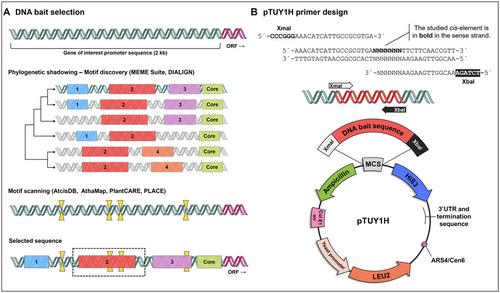Iris Fañanás-Pueyo, Ana-Mariya Anhel, Ángel Goñi-Moreno, Luis Oñate-Sánchez, Gerardo Carrera-Castaño
{"title":"在酵母中选择功能性启动子 DNA 诱饵和筛选阵列基因库的工作流程。","authors":"Iris Fañanás-Pueyo, Ana-Mariya Anhel, Ángel Goñi-Moreno, Luis Oñate-Sánchez, Gerardo Carrera-Castaño","doi":"10.1002/cpz1.70059","DOIUrl":null,"url":null,"abstract":"<p>The yeast one-hybrid system (Y1H) is used extensively to identify DNA–protein interactions. The generation of large collections of open reading frames (ORFs) to be used as prey in screenings is not a bottleneck nowadays and can be carried out in-house or offered as a service by companies. However, the straightforward use of full gene promoters as baits to identify interacting proteins undermines the accuracy and sensitivity of the assay, especially in the case of multicellular eukaryotes. Therefore, it is paramount to implement procedures for efficient identification of suitable promoter fragments compatible with the Y1H assay. Here, we describe a workflow to identify biologically relevant conserved promoter fragments of <i>Arabidopsis thaliana</i> through simple and robust phylogenetic analyses. Additionally, we describe a manual method and its automated robotized version for rapid and efficient high-throughput Y1H screenings of arrayed ORF libraries with the identified DNA fragments. Moreover, this method can be scaled up or down and used for yeast two-hybrid screenings to search for possible interactors of proteins identified by the Y1H approach or any other protein of interest, altogether underscoring its suitability to build gene regulatory networks. © 2024 The Author(s). Current Protocols published by Wiley Periodicals LLC.</p><p><b>Basic Protocol 1</b>: Selection of DNA baits for Y1H screenings</p><p><b>Basic Protocol 2</b>: Y1H screenings with arrayed gene libraries</p><p><b>Alternate Protocol</b>: Automated screening with a liquid-handling robot</p>","PeriodicalId":93970,"journal":{"name":"Current protocols","volume":"4 11","pages":""},"PeriodicalIF":0.0000,"publicationDate":"2024-11-21","publicationTypes":"Journal Article","fieldsOfStudy":null,"isOpenAccess":false,"openAccessPdf":"https://onlinelibrary.wiley.com/doi/epdf/10.1002/cpz1.70059","citationCount":"0","resultStr":"{\"title\":\"Workflow to Select Functional Promoter DNA Baits and Screen Arrayed Gene Libraries in Yeast\",\"authors\":\"Iris Fañanás-Pueyo, Ana-Mariya Anhel, Ángel Goñi-Moreno, Luis Oñate-Sánchez, Gerardo Carrera-Castaño\",\"doi\":\"10.1002/cpz1.70059\",\"DOIUrl\":null,\"url\":null,\"abstract\":\"<p>The yeast one-hybrid system (Y1H) is used extensively to identify DNA–protein interactions. The generation of large collections of open reading frames (ORFs) to be used as prey in screenings is not a bottleneck nowadays and can be carried out in-house or offered as a service by companies. However, the straightforward use of full gene promoters as baits to identify interacting proteins undermines the accuracy and sensitivity of the assay, especially in the case of multicellular eukaryotes. Therefore, it is paramount to implement procedures for efficient identification of suitable promoter fragments compatible with the Y1H assay. Here, we describe a workflow to identify biologically relevant conserved promoter fragments of <i>Arabidopsis thaliana</i> through simple and robust phylogenetic analyses. Additionally, we describe a manual method and its automated robotized version for rapid and efficient high-throughput Y1H screenings of arrayed ORF libraries with the identified DNA fragments. Moreover, this method can be scaled up or down and used for yeast two-hybrid screenings to search for possible interactors of proteins identified by the Y1H approach or any other protein of interest, altogether underscoring its suitability to build gene regulatory networks. © 2024 The Author(s). Current Protocols published by Wiley Periodicals LLC.</p><p><b>Basic Protocol 1</b>: Selection of DNA baits for Y1H screenings</p><p><b>Basic Protocol 2</b>: Y1H screenings with arrayed gene libraries</p><p><b>Alternate Protocol</b>: Automated screening with a liquid-handling robot</p>\",\"PeriodicalId\":93970,\"journal\":{\"name\":\"Current protocols\",\"volume\":\"4 11\",\"pages\":\"\"},\"PeriodicalIF\":0.0000,\"publicationDate\":\"2024-11-21\",\"publicationTypes\":\"Journal Article\",\"fieldsOfStudy\":null,\"isOpenAccess\":false,\"openAccessPdf\":\"https://onlinelibrary.wiley.com/doi/epdf/10.1002/cpz1.70059\",\"citationCount\":\"0\",\"resultStr\":null,\"platform\":\"Semanticscholar\",\"paperid\":null,\"PeriodicalName\":\"Current protocols\",\"FirstCategoryId\":\"1085\",\"ListUrlMain\":\"https://onlinelibrary.wiley.com/doi/10.1002/cpz1.70059\",\"RegionNum\":0,\"RegionCategory\":null,\"ArticlePicture\":[],\"TitleCN\":null,\"AbstractTextCN\":null,\"PMCID\":null,\"EPubDate\":\"\",\"PubModel\":\"\",\"JCR\":\"\",\"JCRName\":\"\",\"Score\":null,\"Total\":0}","platform":"Semanticscholar","paperid":null,"PeriodicalName":"Current protocols","FirstCategoryId":"1085","ListUrlMain":"https://onlinelibrary.wiley.com/doi/10.1002/cpz1.70059","RegionNum":0,"RegionCategory":null,"ArticlePicture":[],"TitleCN":null,"AbstractTextCN":null,"PMCID":null,"EPubDate":"","PubModel":"","JCR":"","JCRName":"","Score":null,"Total":0}
引用次数: 0


 求助内容:
求助内容: 应助结果提醒方式:
应助结果提醒方式:


